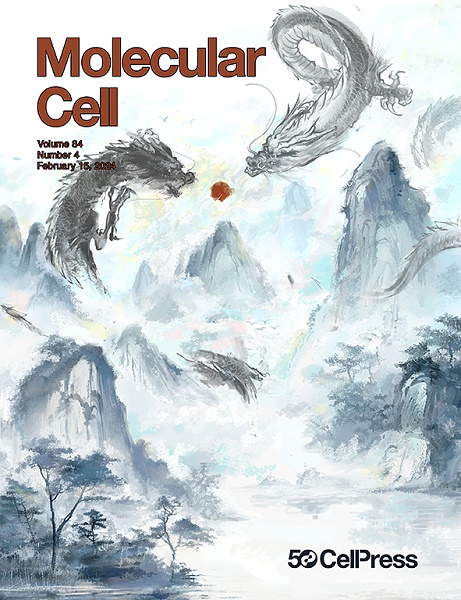ZBP1 senses splicing aberration through Z-RNA to promote cell death
IF 14.5
1区 生物学
Q1 BIOCHEMISTRY & MOLECULAR BIOLOGY
引用次数: 0
Abstract
RNA splicing, a highly regulated process performed by the spliceosome, is essential for eukaryotic gene expression and cellular function. Numerous cellular stresses, including oncogenic insults, dysregulate RNA splicing, often provoking inflammatory responses and cell death. However, the molecular signals generated by splicing aberrations and the mechanism by which cells sense and respond to these signals remain poorly understood. Here, we demonstrate that spliceosome inhibition induces the widespread formation of left-handed Z-form double-stranded RNA (Z-RNA), predominantly derived from mis-spliced exonic and intronic RNA transcripts in the nucleus. These Z-RNAs are exported to the cytoplasm in a RanGTP-dependent manner. Cytosolic sensing of accumulated Z-RNA by the host sensor Z-DNA-binding protein 1 (ZBP1) initiates cell death, primarily through RIPK3-MLKL-dependent necroptosis. Together, these findings reveal a previously uncharacterized mechanism in which ZBP1-mediated detection of Z-RNA serves as a critical response to global RNA splicing perturbations, ultimately triggering inflammatory cell death.

ZBP1通过Z-RNA感知剪接畸变,促进细胞死亡
RNA 剪接是一个由剪接体高度调控的过程,对真核生物的基因表达和细胞功能至关重要。许多细胞压力(包括致癌损伤)会导致 RNA 剪接失调,通常会引发炎症反应和细胞死亡。然而,人们对剪接畸变产生的分子信号以及细胞感知和响应这些信号的机制仍然知之甚少。在这里,我们证明了剪接体抑制会诱导左旋 Z 形双链 RNA(Z-RNA)的广泛形成,这种 RNA 主要来源于细胞核中错误剪接的外显子和内含子 RNA 转录本。这些 Z-RNA 以依赖 RanGTP 的方式输出到细胞质。宿主传感器 Z-DNA 结合蛋白 1(ZBP1)对积累的 Z-RNA 进行细胞膜感应,主要通过 RIPK3-MLKL 依赖性坏死作用启动细胞死亡。这些发现共同揭示了一种以前未曾描述过的机制,在这种机制中,ZBP1 介导的 Z-RNA 检测是对全局 RNA 剪接扰动的关键反应,最终引发炎症细胞死亡。
本文章由计算机程序翻译,如有差异,请以英文原文为准。
求助全文
约1分钟内获得全文
求助全文
来源期刊

Molecular Cell
生物-生化与分子生物学
CiteScore
26.00
自引率
3.80%
发文量
389
审稿时长
1 months
期刊介绍:
Molecular Cell is a companion to Cell, the leading journal of biology and the highest-impact journal in the world. Launched in December 1997 and published monthly. Molecular Cell is dedicated to publishing cutting-edge research in molecular biology, focusing on fundamental cellular processes. The journal encompasses a wide range of topics, including DNA replication, recombination, and repair; Chromatin biology and genome organization; Transcription; RNA processing and decay; Non-coding RNA function; Translation; Protein folding, modification, and quality control; Signal transduction pathways; Cell cycle and checkpoints; Cell death; Autophagy; Metabolism.
 求助内容:
求助内容: 应助结果提醒方式:
应助结果提醒方式:


